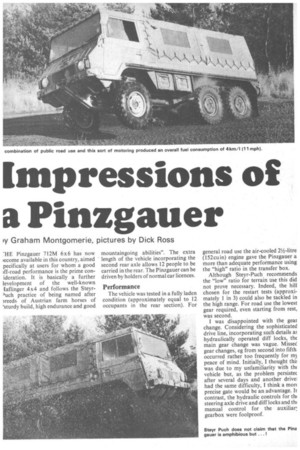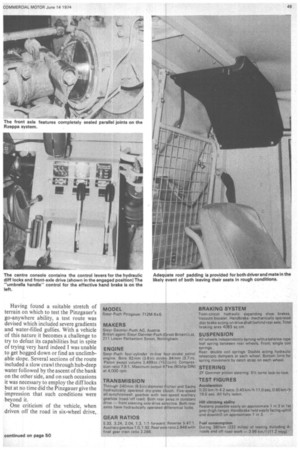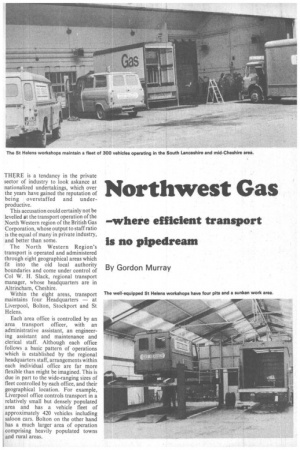Impressions of a Pinzgauer
Page 50

Page 51

Page 52

Page 53

If you've noticed an error in this article please click here to report it so we can fix it.
ly Graham Montgomerie, pictures by Dick Ross
THE Pinzgauer 712M 6 x 6 has now Yecome available in this country, aimed pecifically at users for whom a good iff-road performance is the prime conideration. It is basically a further levelopment of the well-known Iaflinger 4x4 and follows the Steyr3uch practice of being named after 'reeds of Austrian farm horses of 'sturdy build, high endurance and good mountaingoing abilities". The extra length of the vehicle incorporating the second rear axle allows 12 people to be carried in the rear. The Pinzgauer can be driven by holders of normal car licences.
Performance
The vehicle was tested in a fully laden condition (approximately equal to 12 occupants in the rear section). For general road use the air-cooled 21/2-litre (152 cu in) engine gave the Pinzgauer a more than adequate performance using the "high" ratio in the transfer box.
Although Steyr-Puch recommends the "low" ratio for terrain use this did not prove necessary. Indeed, the hill chosen for the restart tests (approximately 1 in 3) could also be tackled in the high range. For road use the lowest gear required, even starting from rest, was second.
I was disappointed with the gear change. Considering the sophisticated drive line, incorporating such details at hydraulically operated diff locks, thc main gear change was vague. Missed gear changes, eg from second into fifth occurred rather too frequently for m3 peace of mind. Initially, I thought thii was due to my unfamiliarity with du vehicle but, as the problem persistec after several days and another drivel had the same difficulty, I think a mori precise gate would be an advantage. Ii contrast, the hydraulic controls for thl steering axle drive and diff locks and till manual control for the auxiliar] gearbox were foolproof. Having found a suitable stretch of terrain on which to test the Pinzgauer's go-anywhere ability, a test route was devised which included severe gradients and water-filled gullies. With a vehicle of this nature it becomes a challenge to try to defeat its capabilities but in spite of trying very hard indeed I was unable to get bogged down or find an unclimbable slope. Several sections of the route included a slow crawl through hub-deep water followed by the ascent of the bank on the other side, and on such occasions it was necessary to employ the diff locks but at no time did the Pinzgauer give the impression that such conditions were beyond it.
One criticism of the vehicle, when driven off the road in six-wheel drive, was the sometimes vicious kick-back on the steering wheel. On public roads with no drive to the steering axle this did not occur but with six-wheel-drive the selfcentring action is extremely powerful.
Braking
The stopping power of the allhydraulic brake system was good but I personally disliked the "dead" feel to the brake pedal. Steyr-Puch claims that the drums are fully sealed against the ingress of water and certain sections of the CM test proved this claim with no change in the effectiveness of the brakes after being driven totally immersed in water. Although it is only a matter of personal taste I prefer more feel to the brake pedal and this detracted somewhat from my confidence in the vehicle. Against this the handbrake was the most effective I have encountered on any vehicle, be it private car or heavy truck Without undue effort in application this mechanically applied disc brake operating on a drive shaft behind the rear axle held the Pinzgauer easily, full) laden, on the steepest slopes I could finc (maximum gradient approximately 1 ir 3).
The fuel consumption measured ovei nearly 400km (248 miles) incorporating both on-and-off road conditions worked out at approximately 4 km/ : (II mpg) which does not give the Pinzgauer a very wide range on a full tank.
Interior layout
Although vehicles of this type tend to have cabs of a functional nature there were signs that driver comfort has not been entirely forgotten. An example of this was the provision of a padded cushion above the driver's head in the cab, a similar one being fitted above the front passenger seat. Whether this was intended as a criticism of the off-road ride of the Pinzgauer or a genuine thought towards driver comfort was uncertain.
The major controls were well positioned and one feature that I particularly liked was the generous size of the throttle pedal which was particularly advantageous on bumpy sections as it allowed the right foot to regain maximum control as soon as possible after a severe bump.
The all-wheel-drive and diff-lock controls were within comfortable reach and very easy to operate. The auxiliary gearbox lever was somewhat more difficult. In fact, if the driver was wearing the safety belt this control would be out of reach from the driving seat. As I found it impossible to maintain the safety belt in its correct position anyway — a common fault in commercial vehicles — this restriction was not severe.
The windscreen washers and wipers were reasonably effective without being outstanding although I would severely criticize the Steyr-Puch in this area on two counts. The washer reservoir capacity is ridiculously small considering the type of road conditions likely to be encountered and secondly the offside mirror is viewed through an area of the front screen which is not covered by the wipers.
Summary
The Pinzgauer 6 x 6 does all that the manufacturer claims it will do both on and off the road. However, concerning its go-anywhere claims, with three axles, all driven complete with optional difflocks, it ought to go anywhere. The price of £6,995 (+ VAT) will mean that the Steyr-Puch will enjoy a fairly limited market when one considers that this financial outlay will obtain about three I Land-Rovers. THERE is a tendancy in the private sector of industry to look askance at nationalized undertakings, which over the years have gained the reputation of being overstaffed and underproductive.
This accusation could certainly not be levelled at the transport operation of the North Western region of the British Gas Corporation, whose output to staff ratio is the equal of many in private industry, and better than some.
The North Western Region's transport is operated and administered through eight geographical areas which fit into the old local authority boundaries and come under control of Col W. H. Slack, regional transport manager, whose headquarters are in Altrincham, Cheshire.
Within the eight areas, transport maintains four Headquarters — at Liverpool, Bolton, Stockport and St Helens.
Each area office is controlled by an area transport officer, with an administrative assistant, an engineer ing assistant and maintenance and clerical staff. Although each office follows a basic pattern of operations which is established by the regional headquarters staff, arrangements within each individual office are far more flexible than might be imagined. This is due in part to the wide-ranging sizes of fleet controlled by each office, and their geographical location. For example, Liverpool office controls transport in a relatively small but densely populated area and has a vehicle fleet of approximately 420 vehicles including saloon cars. Bolton on the other hand has a much larger area of operation comprising heavily populated towns and rural areas.




























































































































